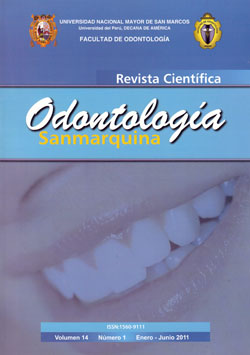In vitro evaluation of three gutta-percha solvents
DOI:
https://doi.org/10.15381/os.v14i1.2828Keywords:
Gutta-percha, Organic solvents, Orange oilAbstract
The purpose of this study was to evaluate the solubility of gutta-percha in three solvents used in endodontics: xylol of traditional use, and the essential oils: eucalyptol and orange oil, of recent use, given the frequent need to remove the obturation material in radicular retreatment procedures. One hundred twenty samples of gutta-percha were prepared in a standardized way in small cylinders, being divided equally into four groups for immersion in three experimental solvents and distilled water (control group) during 2.5 and 10 minutes at room temperature. The solvent effect was recorded in grams of weight loss, calculating the difference between pre and post-immersion samples weight for each experimental time. The results were analyzed and compared by Tukey test (p <0.05). Under the conditions of this study it is concluded that, all experimental solvents were effective to dissolve gutta-percha. Xylol showed superior solvent effects in all experimental times. Orange oil and eucalyptol presented similar solvent effects.Downloads
Downloads
Published
Issue
Section
License
Copyright (c) 2011 Martha Elena Pineda Mejía, Elmo Sigifredo Palacios Alva, Liliana Ángela Terán Casafranca, María Elena Núñez Lizárraga, Waldo Ernesto Gloria Zevallos, Tulio Abuhadba Hoyos

This work is licensed under a Creative Commons Attribution-NonCommercial-ShareAlike 4.0 International License.
AUTHORS RETAIN THEIR RIGHTS:
a. Authors retain their trade mark rights and patent, and also on any process or procedure described in the article.
b. Authors retain their right to share, copy, distribute, perform and publicly communicate their article (eg, to place their article in an institutional repository or publish it in a book), with an acknowledgment of its initial publication in the Odontología Sanmarquina.
c. Authors retain theirs right to make a subsequent publication of their work, to use the article or any part thereof (eg a compilation of his papers, lecture notes, thesis, or a book), always indicating the source of publication (the originator of the work, journal, volume, number and date).






